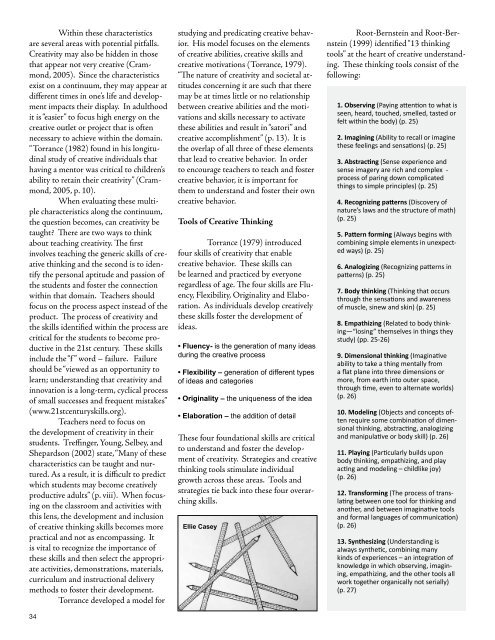Torrance Journal for Applied Creativity
TorranceJournal_V1
TorranceJournal_V1
Create successful ePaper yourself
Turn your PDF publications into a flip-book with our unique Google optimized e-Paper software.
Within these characteristics<br />
are several areas with potential pitfalls.<br />
<strong>Creativity</strong> may also be hidden in those<br />
that appear not very creative (Crammond,<br />
2005). Since the characteristics<br />
exist on a continuum, they may appear at<br />
different times in one’s life and development<br />
impacts their display. In adulthood<br />
it is “easier” to focus high energy on the<br />
creative outlet or project that is often<br />
necessary to achieve within the domain.<br />
“<strong>Torrance</strong> (1982) found in his longitudinal<br />
study of creative individuals that<br />
having a mentor was critical to children’s<br />
ability to retain their creativity” (Crammond,<br />
2005, p. 10).<br />
When evaluating these multiple<br />
characteristics along the continuum,<br />
the question becomes, can creativity be<br />
taught? There are two ways to think<br />
about teaching creativity. The first<br />
involves teaching the generic skills of creative<br />
thinking and the second is to identify<br />
the personal aptitude and passion of<br />
the students and foster the connection<br />
within that domain. Teachers should<br />
focus on the process aspect instead of the<br />
product. The process of creativity and<br />
the skills identified within the process are<br />
critical <strong>for</strong> the students to become productive<br />
in the 21st century. These skills<br />
include the “f ” word – failure. Failure<br />
should be “viewed as an opportunity to<br />
learn; understanding that creativity and<br />
innovation is a long-term, cyclical process<br />
of small successes and frequent mistakes”<br />
(www.21stcenturyskills.org).<br />
Teachers need to focus on<br />
the development of creativity in their<br />
students. Treffinger, Young, Selbey, and<br />
Shepardson (2002) state, “Many of these<br />
characteristics can be taught and nurtured.<br />
As a result, it is difficult to predict<br />
which students may become creatively<br />
productive adults” (p. viii). When focusing<br />
on the classroom and activities with<br />
this lens, the development and inclusion<br />
of creative thinking skills becomes more<br />
practical and not as encompassing. It<br />
is vital to recognize the importance of<br />
these skills and then select the appropriate<br />
activities, demonstrations, materials,<br />
curriculum and instructional delivery<br />
methods to foster their development.<br />
<strong>Torrance</strong> developed a model <strong>for</strong><br />
34<br />
studying and predicating creative behavior.<br />
His model focuses on the elements<br />
of creative abilities, creative skills and<br />
creative motivations (<strong>Torrance</strong>, 1979).<br />
“The nature of creativity and societal attitudes<br />
concerning it are such that there<br />
may be at times little or no relationship<br />
between creative abilities and the motivations<br />
and skills necessary to activate<br />
these abilities and result in “satori” and<br />
creative accomplishment” (p. 13). It is<br />
the overlap of all three of these elements<br />
that lead to creative behavior. In order<br />
to encourage teachers to teach and foster<br />
creative behavior, it is important <strong>for</strong><br />
them to understand and foster their own<br />
creative behavior.<br />
Tools of Creative Thinking<br />
<strong>Torrance</strong> (1979) introduced<br />
four skills of creativity that enable<br />
creative behavior. These skills can<br />
be learned and practiced by everyone<br />
regardless of age. The four skills are Fluency,<br />
Flexibility, Originality and Elaboration.<br />
As individuals develop creatively<br />
these skills foster the development of<br />
ideas.<br />
• Fluency- is the generation of many ideas<br />
during the creative process<br />
• Flexibility – generation of different types<br />
of ideas and categories<br />
• Originality – the uniqueness of the idea<br />
• Elaboration – the addition of detail<br />
These four foundational skills are critical<br />
to understand and foster the development<br />
of creativity. Strategies and creative<br />
thinking tools stimulate individual<br />
growth across these areas. Tools and<br />
strategies tie back into these four overarching<br />
skills.<br />
Ellie Casey<br />
Root-Bernstein and Root-Bernstein<br />
(1999) identified “13 thinking<br />
tools” at the heart of creative understanding.<br />
These thinking tools consist of the<br />
following:<br />
1. Observing (Paying attention to what is<br />
seen, heard, touched, smelled, tasted or<br />
felt within the body) (p. 25)<br />
2. Imagining (Ability to recall or imagine<br />
these feelings and sensations) (p. 25)<br />
3. Abstracting (Sense experience and<br />
sense imagery are rich and complex -<br />
process of paring down complicated<br />
things to simple principles) (p. 25)<br />
4. Recognizing patterns (Discovery of<br />
nature’s laws and the structure of math)<br />
(p. 25)<br />
5. Pattern <strong>for</strong>ming (Always begins with<br />
combining simple elements in unexpected<br />
ways) (p. 25)<br />
6. Analogizing (Recognizing patterns in<br />
patterns) (p. 25)<br />
7. Body thinking (Thinking that occurs<br />
through the sensations and awareness<br />
of muscle, sinew and skin) (p. 25)<br />
8. Empathizing (Related to body thinking—“losing”<br />
themselves in things they<br />
study) (pp. 25-26)<br />
9. Dimensional thinking (Imaginative<br />
ability to take a thing mentally from<br />
a flat plane into three dimensions or<br />
more, from earth into outer space,<br />
through time, even to alternate worlds)<br />
(p. 26)<br />
10. Modeling (Objects and concepts often<br />
require some combination of dimensional<br />
thinking, abstracting, analogizing<br />
and manipulative or body skill) (p. 26)<br />
11. Playing (Particularly builds upon<br />
body thinking, empathizing, and play<br />
acting and modeling – childlike joy)<br />
(p. 26)<br />
12. Trans<strong>for</strong>ming (The process of translating<br />
between one tool <strong>for</strong> thinking and<br />
another, and between imaginative tools<br />
and <strong>for</strong>mal languages of communication)<br />
(p. 26)<br />
13. Synthesizing (Understanding is<br />
always synthetic, combining many<br />
kinds of experiences – an integration of<br />
knowledge in which observing, imagining,<br />
empathizing, and the other tools all<br />
work together organically not serially)<br />
(p. 27)


